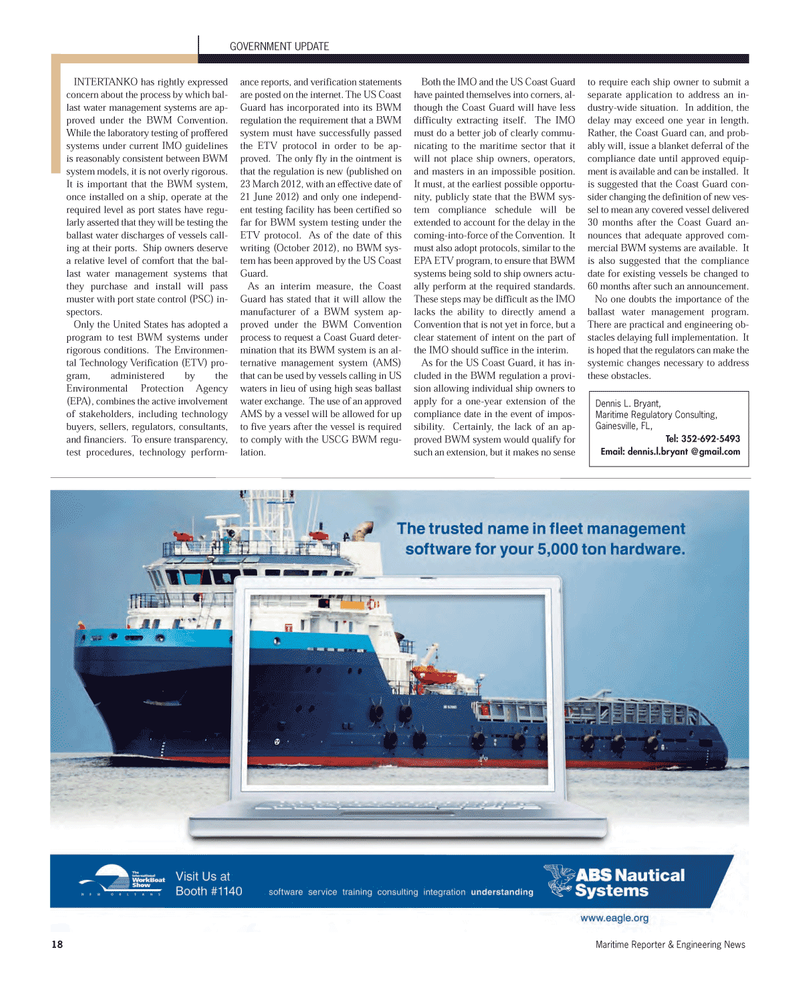
Page 18: of Maritime Reporter Magazine (November 2012)
Workboat Annual
Read this page in Pdf, Flash or Html5 edition of November 2012 Maritime Reporter Magazine
18Maritime Reporter & Engineering News INTERTANKO has rightly expressed concern about the process by which bal-last water management systems are ap- proved under the BWM Convention. While the laboratory testing of proffered systems under current IMO guidelinesis reasonably consistent between BWMsystem models, it is not overly rigorous. It is important that the BWM system,once installed on a ship, operate at therequired level as port states have regu- larly asserted that they will be testing the ballast water discharges of vessels call- ing at their ports. Ship owners deserve a relative level of comfort that the bal- last water management systems that they purchase and install will pass muster with port state control (PSC) in-spectors.Only the United States has adopted aprogram to test BWM systems underrigorous conditions. The Environmen- tal Technology Verification (ETV) pro- gram, administered by theEnvironmental Protection Agency (EPA), combines the active involvement of stakeholders, including technology buyers, sellers, regulators, consultants, and financiers. To ensure transparency, test procedures, technology perform- ance reports, and verification statements are posted on the internet. The US Coast Guard has incorporated into its BWMregulation the requirement that a BWM system must have successfully passed the ETV protocol in order to be ap-proved. The only fly in the ointment is that the regulation is new (published on 23 March 2012, with an effective date of 21 June 2012) and only one independ-ent testing facility has been certified so far for BWM system testing under the ETV protocol. As of the date of this writing (October 2012), no BWM sys-tem has been approved by the US Coast Guard.As an interim measure, the CoastGuard has stated that it will allow the manufacturer of a BWM system ap- proved under the BWM Convention process to request a Coast Guard deter- mination that its BWM system is an al-ternative management system (AMS) that can be used by vessels calling in US waters in lieu of using high seas ballast water exchange. The use of an approved AMS by a vessel will be allowed for up to five years after the vessel is required to comply with the USCG BWM regu- lation. Both the IMO and the US Coast Guardhave painted themselves into corners, al- though the Coast Guard will have less difficulty extracting itself. The IMO must do a better job of clearly commu-nicating to the maritime sector that itwill not place ship owners, operators, and masters in an impossible position.It must, at the earliest possible opportu- nity, publicly state that the BWM sys- tem compliance schedule will beextended to account for the delay in the coming-into-force of the Convention. It must also adopt protocols, similar to theEPA ETV program, to ensure that BWM systems being sold to ship owners actu- ally perform at the required standards.These steps may be difficult as the IMO lacks the ability to directly amend aConvention that is not yet in force, but a clear statement of intent on the part ofthe IMO should suffice in the interim. As for the US Coast Guard, it has in-cluded in the BWM regulation a provi- sion allowing individual ship owners to apply for a one-year extension of the compliance date in the event of impos- sibility. Certainly, the lack of an ap- proved BWM system would qualify for such an extension, but it makes no sense to require each ship owner to submit a separate application to address an in-dustry-wide situation. In addition, thedelay may exceed one year in length. Rather, the Coast Guard can, and prob- ably will, issue a blanket deferral of the compliance date until approved equip- ment is available and can be installed. It is suggested that the Coast Guard con-sider changing the definition of new ves- sel to mean any covered vessel delivered 30 months after the Coast Guard an-nounces that adequate approved com- mercial BWM systems are available. It is also suggested that the compliancedate for existing vessels be changed to 60 months after such an announcement.No one doubts the importance of theballast water management program. There are practical and engineering ob-stacles delaying full implementation. Itis hoped that the regulators can make the systemic changes necessary to addressthese obstacles.GOVERNMENT UPDATE Dennis L. Bryant, Maritime Regulatory Consulting,Gainesville, FL, Tel: 352-692-5493 Email: dennis.l.bryant @gmail.com MR#11 (18-25):MR Template 11/5/2012 3:43 PM Page 18

 17
17

 19
19
